Irrigation Scheduling
The exact scheduling of irrigation is very important because:
- Both, too high and too small water applications result in negative effects on yield, plant health and environment.
- Nutrient availability and uptake are influenced strongly by soil moisture conditions.
- Each irrigation event is causing cost.
Benefits of exact irrigation scheduling are therefore:
- increased yield
- improved quality
- savings in money and natural resources
Necessary for appropriate irrigation scheduling is:
- exact determination of irrigation frequency
- exact determination of irrigation water amount
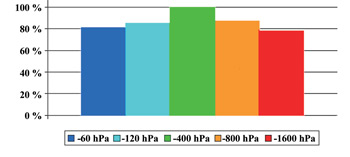
Example: Yield-effect of soil water potential in raspberries
To collect this information, various approaches are common. Following some background information, these approaches will be discussed briefly.
Soil and Soilwater
Soil consists of soil particles (mineral or organic) and the soil pores, which are either filled with water or air. Depending on the average size of soil particles (soil type), structure, compaction and organic matter content, total pore volume greatly varies from soil to soil. Total pore volume is key factor for water storage capacity of any soil.
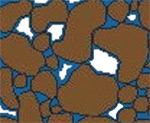
The narrower the diameter of water filled pores, the stronger the force with which water is bound by soil, and plants have to apply more energy to extract it. This force is called soil water potential or soil water suction.
The term fieldcapacity refers to the amount of water a soil can hold back against gravity (the soil water content at a soil water potential of approx. 60 hPa or pF 1,8). Plant usable fieldcapacity is the amount of water, bound in soil with a soil water potential between 60 (pF 1,8) and 15 000 hPa (pF 4,2), i.e. Plant usable field capacity equals field capacity minus the water, which is bound so strongly in soil, that it can not be taken up by plants any more. (non plant available water).
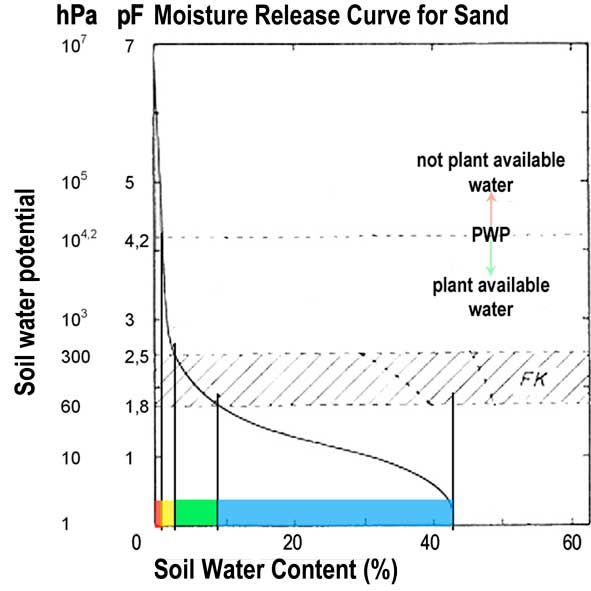
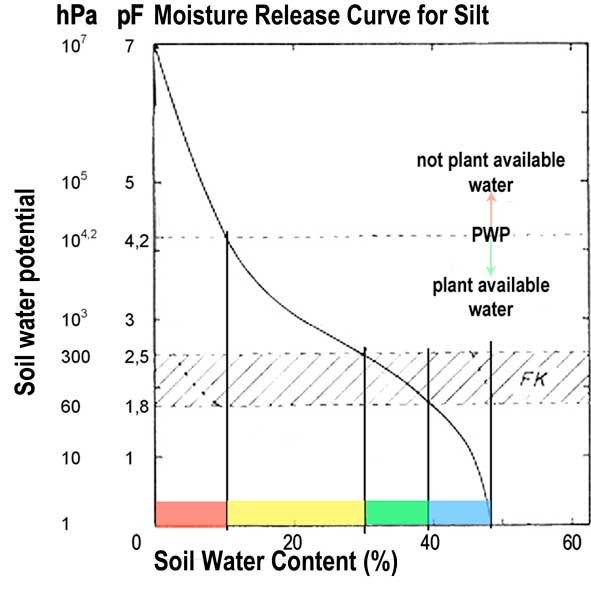
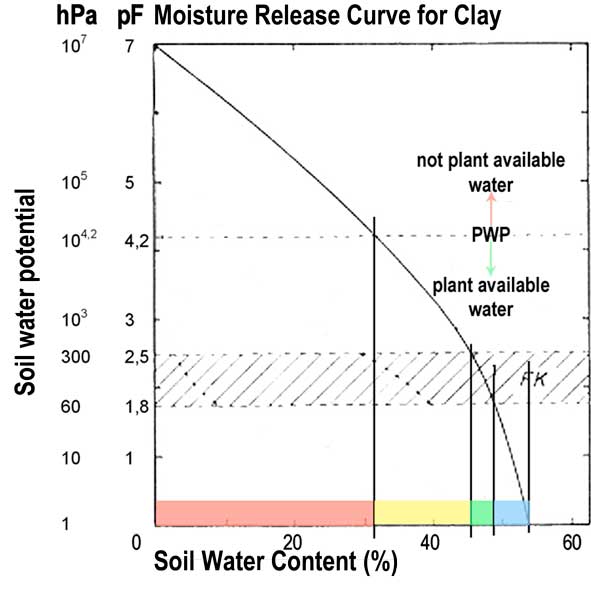
Due to above described circumstances the amount of plant available soil water is varying strongly between soils. Example: Plant available water of a typical sand ranges between approx. 5 and 15% absolute water content, while plant available water of a typical clay soil ranges between approx. 30 and 50% water content.
Irrigation scheduling Approaches
A - Measurement of Soil Water Potential
This approach measures the soil water potential as indicator of water availability for plant uptake in soils. Measuring soil water potential provides information on the force with which water is bound by soil (= energy plants have to apply to extract it), but it gives no information on the amount of water contained in this soil. Common measurement units for soil water potential are hPa (1 hPa = 1 mbar) and kPa (1 kPa= 1 Centibar = 10 hPa / mbar).
Measuring soil water potential is the classical approach of irrigation scheduling. It is possible to transfer values of soil water potential from soil type to soil type, i.e. it is of minor importance in which soil a measurement is taken. For example a measured soil water potential of 150 hPa results in the same information weather this measurement has been taken in a sand or in a clay soil. Clearly defined optimum ranges do exist for all major crops, and crop development stages, which are valid for all soil types. For best results three measurement sites, each in two depth are recommended per irrigation unit..
Tensiometer and Watermark Sensor are instruments to measure soil water potential. Tensiometers yield very accurate results in the moist end of the range (0 to approx. 800 hPa), and are successfully used in almost all growing systems and crops, grown in mineral soil and substrates. Tensiometers show best results in drip irrigation systems.
Good irrigation scheduling results in optimal moisture conditions and nutrient availability in the whole main root-zone, without losses due to deep percolation.
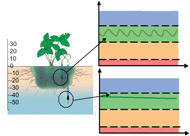
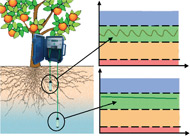
Pictures:
blue: - too wet
green - optimal moisture
orange / red - too dry
B - Measurement of Volumetric Soil Water Content
This approach uses instruments to measure the volumetric water content of soil. It yields information on the total water content, including the not plant available part of it in a given unit of soil. This approach provides no information on the energy which is necessary to extract water from this soil. Common units in volumetric measurement are mm, Vol. % or liter of water per liter or m³ of soil
Volumetric measurement values can not be transferred between different soil types. Example: The measurement result of 30% water content would mean for a sand saturation (soil water potential approx. 10 hPa or pF 1,0), while a silty soil would show a soil water potential of approx. 300 hPa or pF 2,5. A clay soil at 30% water content would be close to the permanent wilting point (soil water potential approx. 15000 hPa or pF 4,2).
TDR Fieldscout and FDR ECH2O Sensor are instruments to measure the volumetric soil water content. Volumetric probes and measurement instruments are the ideal tool to answer the question how much water to apply per gift.
C - Measurement of Leaf- and Stem Water Potential
This approach measures directly the leaf- or stem water potential, the tension of the xylem water in a plant, with a Scholander pressure chamber. It provides direct information on the water status of a plant, and thus on water availability in the whole rooted zone of this plant. Common measurement units are MPa and bar. (1 MPa = 10 bar)
Values from measurements with a Scholander chamber can be transferred between sites. Clearly defined optimum ranges do exist mainly for trees and vines. The measuring process itself however is labour intensive and can not be automated. Scholander chambers are most commonly used in grape production and research.
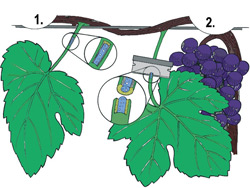
- Xylem water column in a plant is always under tension.
- When cut, water column retreats into leaf
D - Climatic Water Balancef
The climatic water balance (also Geisenheimer Methode) is an indirect approach. Based on environmental data, the potential evapotranspiration (= transpiration of plants + evaporation from soil) is calculated for a specific area and time period (most common formula: Penman-Monteith). In a second step, this value is corrected with an empirical factor Kc (Kc determined by crop and development stage) to the actual evapotranspiration. Finally eventual rainfall is subtracted.
The climatic water balance yields information on the water loss in mm over a given period of time. The calculation must be performed for every individual field and crop. For most crops and crop development stages various Kc correction factors do exist. Some of the iMetos automatic weather station models offer an automated climatic water balance.
Example: 
 EN
EN  DE
DE  IT
IT  FR
FR  ES
ES 